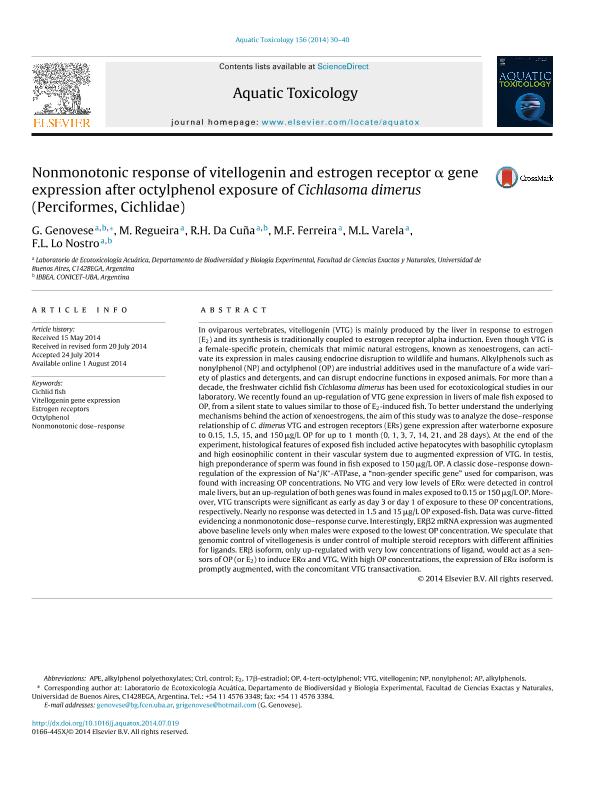Artículo
Nonmonotonic response of vitellogenin and estrogen receptor geneexpression after octylphenol exposure of Cichlasoma dimerus(Perciformes, Cichlidae)
Genovese, Griselda ; Regueira, Mariana
; Regueira, Mariana ; Da Cuña, Rodrigo Hernán
; Da Cuña, Rodrigo Hernán ; Ferreira, Maria Florencia
; Ferreira, Maria Florencia ; Varela, María Luisa
; Varela, María Luisa ; Lo Nostro, Fabiana Laura
; Lo Nostro, Fabiana Laura
 ; Regueira, Mariana
; Regueira, Mariana ; Da Cuña, Rodrigo Hernán
; Da Cuña, Rodrigo Hernán ; Ferreira, Maria Florencia
; Ferreira, Maria Florencia ; Varela, María Luisa
; Varela, María Luisa ; Lo Nostro, Fabiana Laura
; Lo Nostro, Fabiana Laura
Fecha de publicación:
08/2014
Editorial:
Elsevier Science
Revista:
Aquatic Toxicology
ISSN:
0166-445X
Idioma:
Inglés
Tipo de recurso:
Artículo publicado
Clasificación temática:
Resumen
In oviparous vertebrates, vitellogenin (VTG) is mainly produced by the liver in response to estrogen(E2) and its synthesis is traditionally coupled to estrogen receptor alpha induction. Even though VTG isa female-specific protein, chemicals that mimic natural estrogens, known as xenoestrogens, can acti-vate its expression in males causing endocrine disruption to wildlife and humans. Alkylphenols such asnonylphenol (NP) and octylphenol (OP) are industrial additives used in the manufacture of a wide vari-ety of plastics and detergents, and can disrupt endocrine functions in exposed animals. For more than adecade, the freshwater cichlid fish Cichlasoma dimerus has been used for ecotoxicological studies in ourlaboratory. We recently found an up-regulation of VTG gene expression in livers of male fish exposed toOP, from a silent state to values similar to those of E2-induced fish. To better understand the underlyingmechanisms behind the action of xenoestrogens, the aim of this study was to analyze the dose?responserelationship of C. dimerus VTG and estrogen receptors (ERs) gene expression after waterborne exposureto 0.15, 1.5, 15, and 150 g/L OP for up to 1 month (0, 1, 3, 7, 14, 21, and 28 days). At the end of theexperiment, histological features of exposed fish included active hepatocytes with basophilic cytoplasmand high eosinophilic content in their vascular system due to augmented expression of VTG. In testis,high preponderance of sperm was found in fish exposed to 150 g/L OP. A classic dose?response down-regulation of the expression of Na+/K+-ATPase, a ?non-gender specific gene? used for comparison, wasfound with increasing OP concentrations. No VTG and very low levels of ER were detected in controlmale livers, but an up-regulation of both genes was found in males exposed to 0.15 or 150 g/L OP. More-over, VTG transcripts were significant as early as day 3 or day 1 of exposure to these OP concentrations,respectively. Nearly no response was detected in 1.5 and 15 g/L OP exposed-fish. Data was curve-fittedevidencing a nonmonotonic dose?response curve. Interestingly, ER2 mRNA expression was augmentedabove baseline levels only when males were exposed to the lowest OP concentration. We speculate thatgenomic control of vitellogenesis is under control of multiple steroid receptors with different affinitiesfor ligands. ER isoform, only up-regulated with very low concentrations of ligand, would act as a sen-sors of OP (or E2) to induce ER and VTG. With high OP concentrations, the expression of ER isoform ispromptly augmented, with the concomitant VTG transactivation.
Archivos asociados
Licencia
Identificadores
Colecciones
Articulos(CEDIE)
Articulos de CENTRO DE INVESTIGACIONES ENDOCRINOLOGICAS "DR. CESAR BERGADA"
Articulos de CENTRO DE INVESTIGACIONES ENDOCRINOLOGICAS "DR. CESAR BERGADA"
Articulos(IBBEA)
Articulos de INSTITUTO DE BIODIVERSIDAD Y BIOLOGIA EXPERIMENTAL Y APLICADA
Articulos de INSTITUTO DE BIODIVERSIDAD Y BIOLOGIA EXPERIMENTAL Y APLICADA
Citación
Lo Nostro, Fabiana Laura; Varela, María Luisa; Ferreira, Maria Florencia; Da Cuña, Rodrigo Hernán; Regueira, Mariana; Genovese, Griselda; et al.; Nonmonotonic response of vitellogenin and estrogen receptor geneexpression after octylphenol exposure of Cichlasoma dimerus(Perciformes, Cichlidae); Elsevier Science; Aquatic Toxicology; 156; 8-2014; 30-40
Compartir
Altmétricas



